 Yesterday, Phii Laa, my neighbour, came over with the tray of ingredients pictured above and a desire to share her recipe for saa, a local type of yam or Thai-style ‘salad’. I was excited about this because in Mae Hong Son there are several variations on the standard Thai yam that I've yet to get my head around: there’s the type I mentioned in the previous blog, that uses par-boiled veggies; there’s sanaap, which apparently combines par-boiled veggies and a rather different dressing; and finally there’s saa, which appears to revolve around fresh greens.
Yesterday, Phii Laa, my neighbour, came over with the tray of ingredients pictured above and a desire to share her recipe for saa, a local type of yam or Thai-style ‘salad’. I was excited about this because in Mae Hong Son there are several variations on the standard Thai yam that I've yet to get my head around: there’s the type I mentioned in the previous blog, that uses par-boiled veggies; there’s sanaap, which apparently combines par-boiled veggies and a rather different dressing; and finally there’s saa, which appears to revolve around fresh greens.
The most common greens used to make saa range from tender mango or tamarind leaves to shredded lettuce. In this recipe Phii Laa used yot thua lantao, the tender young leaves from a type of pea, which she has growing in front of her house. If you're making this at home, I reckon you could use just about any salad-type green.
Regarding the other ingredients, keep in mind that the type of sesame oil people in Mae Hong Son use is made from raw, not roasted sesame seeds. The flavour is significantly subtler, and if you can only get the more ubiquitous Chinese-style roasted sesame oil, I’d suggest diluting it with equal parts plain vegetable oil.
And many cooks here protein up their saa with bits of plaa thoo, steamed mackerel, but a few still do it the old-school way: with bits of deep-fried pork rind.
Saa (Shan/Thai Yai-style yam using fresh greens)

Fresh greens, sliced thinly, 1 large bunch Shallots, sliced thinly, 3 Tomatoes, seeded and sliced thinly, 3 Steamed mackerel or pork rinds Roasted peanuts, ground coarsely, 3 Tbsp Nam phrik phong, 1 Tbsp (see previous blog for a description of this ingredient) Sesame oil/garlic oil, 1 Tbsp Salt, to taste
Combine greens, shallots, tomatoes and fish or pork rinds, in a large bowl. Top with peanuts, a pinch of salt, oil and nam phrik phong:

Mix thoroughly by hand:

and season to taste. Serve on its own as a snack or with rice.












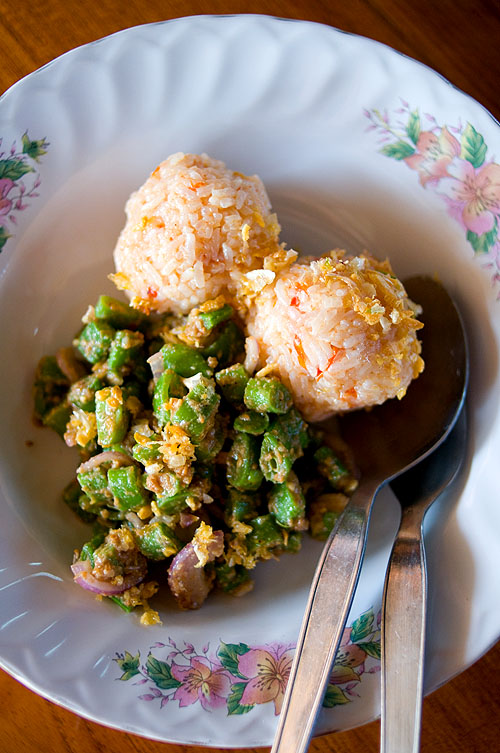 I’m in very good culinary company here in Mae Hong Son. As soon the owner of the house I’m renting learned that I have an interest in the local food, she started bringing me local sweets and snacks on a daily basis. This morning she went out of her way to bring me a local dish of sticky rice steamed with coconut milk and turmeric and served with local-style meatballs (more on this later), something that I had mentioned the previous day. My next-door neighbour, Phii Laa, is equally generous, and possibly even more enthusiastic. Once she learned that I was interested in the local eats she’s been in my kitchen every morning since, sharing a new recipe.
I’m in very good culinary company here in Mae Hong Son. As soon the owner of the house I’m renting learned that I have an interest in the local food, she started bringing me local sweets and snacks on a daily basis. This morning she went out of her way to bring me a local dish of sticky rice steamed with coconut milk and turmeric and served with local-style meatballs (more on this later), something that I had mentioned the previous day. My next-door neighbour, Phii Laa, is equally generous, and possibly even more enthusiastic. Once she learned that I was interested in the local eats she’s been in my kitchen every morning since, sharing a new recipe.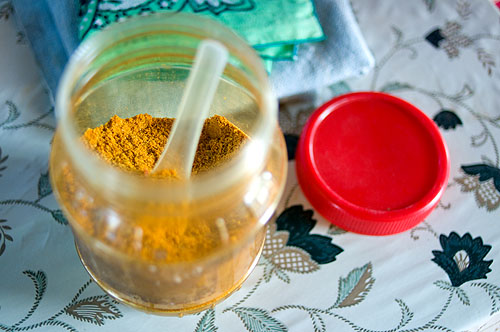
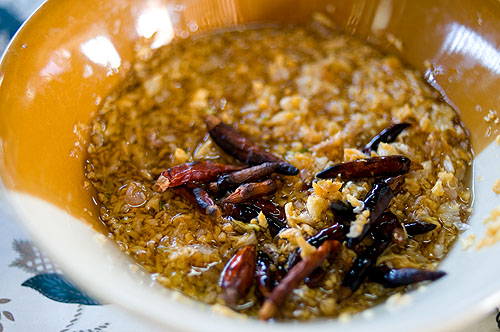
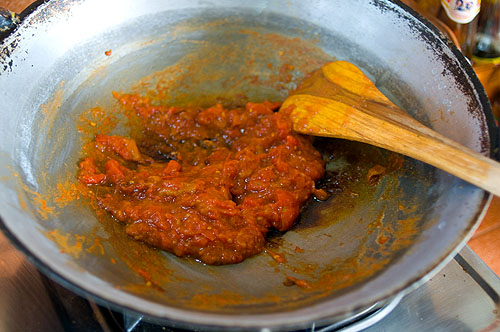
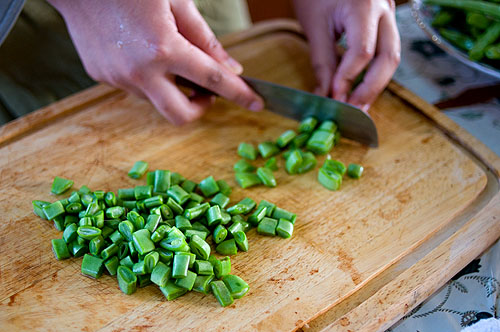
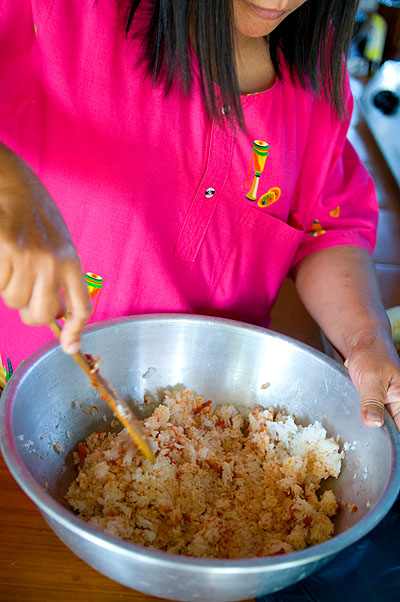
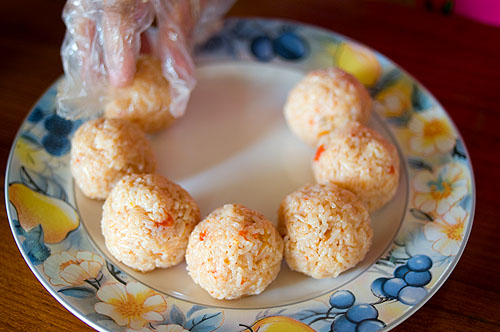

 Khao ya koo is the Shan/Thai Yai name for a type of sweetened sticky rice. Other than simply being a sweet snack, the dish has strong associations with celebration, as it's only made on certain holidays. It also has ties with community, and as you'll see, is one distinctly local method of making merit (kwaa loo in the local dialect).
Khao ya koo is the Shan/Thai Yai name for a type of sweetened sticky rice. Other than simply being a sweet snack, the dish has strong associations with celebration, as it's only made on certain holidays. It also has ties with community, and as you'll see, is one distinctly local method of making merit (kwaa loo in the local dialect).










 This is a Thai Yai/Shan dish that one sees for sale all over Mae Hong Son, and it combines ingredients essential to virtually every local dish: soybeans (both in the form of tofu and thua nao, disks of dried soybeans), garlic, tomatoes and turmeric. However, just like any other dish, there appears to be several different ways to make thua phoo khua. My neighbour claims that thua nao has no place in the chili paste of this dish, and that she normally uses fresh chilies. The ladies selling meat in the morning market told me that I have to use thua nao and dried chilies... I've followed the latter method, combined with a recipe from a Thai-language cookbook printed in Mae Hong Son.
This is a Thai Yai/Shan dish that one sees for sale all over Mae Hong Son, and it combines ingredients essential to virtually every local dish: soybeans (both in the form of tofu and thua nao, disks of dried soybeans), garlic, tomatoes and turmeric. However, just like any other dish, there appears to be several different ways to make thua phoo khua. My neighbour claims that thua nao has no place in the chili paste of this dish, and that she normally uses fresh chilies. The ladies selling meat in the morning market told me that I have to use thua nao and dried chilies... I've followed the latter method, combined with a recipe from a Thai-language cookbook printed in Mae Hong Son.




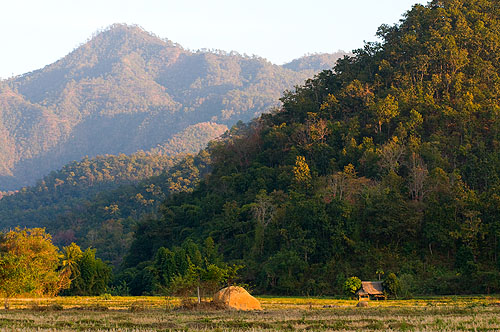
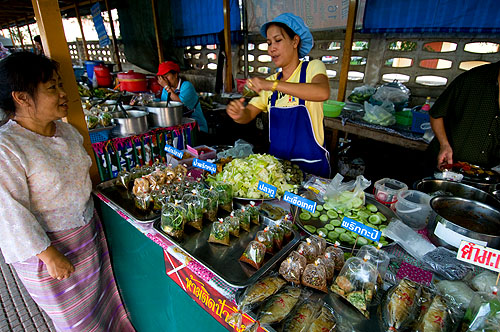
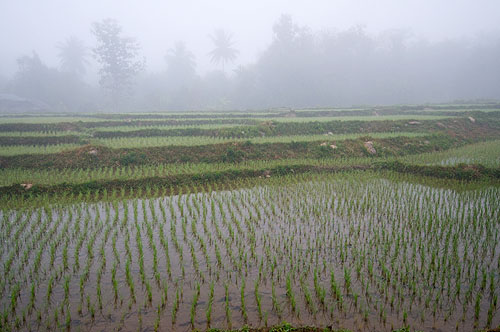
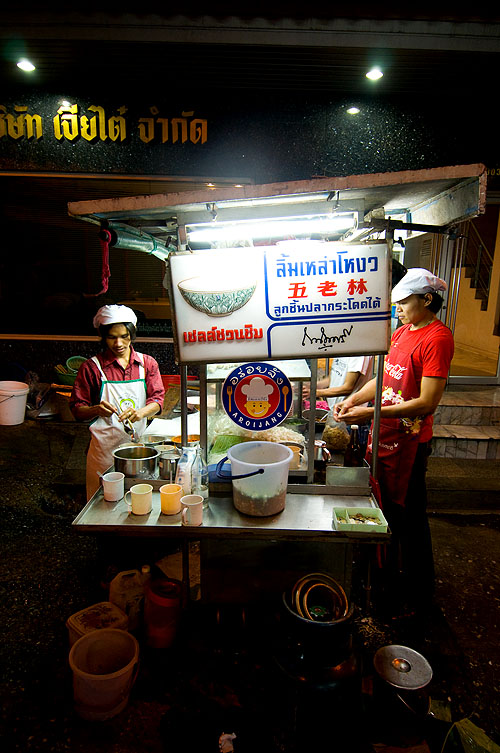 The tongue-twistingly difficult name of this street stall is Chinese in origin, appropriate for a stall on the outer edges of Bangkok’s Chinatown. I was escorted there by David Thompson, who knows the neighbourhood a lot better than I’d expected.
The tongue-twistingly difficult name of this street stall is Chinese in origin, appropriate for a stall on the outer edges of Bangkok’s Chinatown. I was escorted there by David Thompson, who knows the neighbourhood a lot better than I’d expected.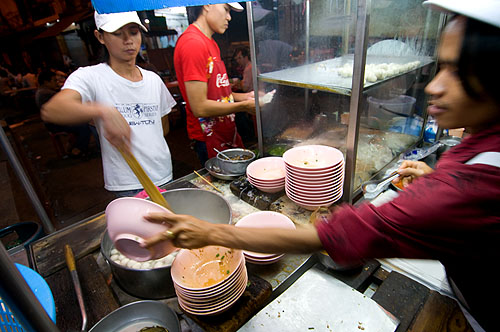
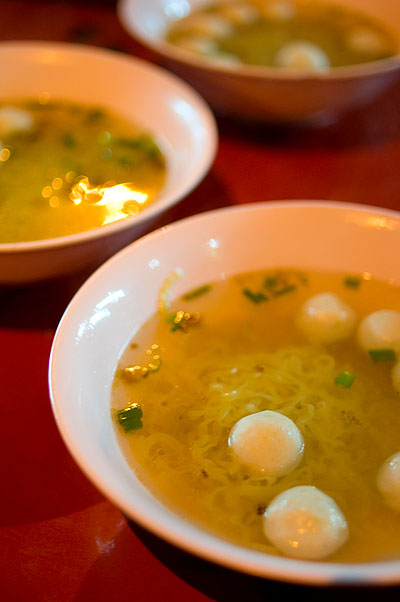
 The title of this post is a take on the oft-cited 2005
The title of this post is a take on the oft-cited 2005 





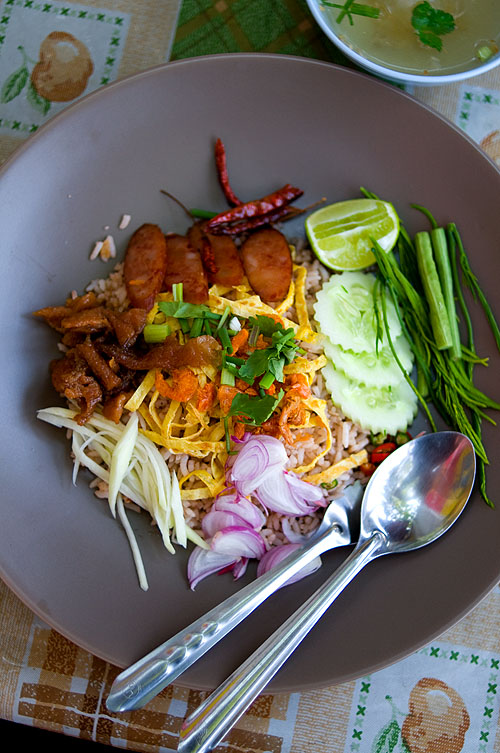 Lying just steps from the famous backpacker district of Th Khao San, you'd think that there would be much in the way of authentic Thai food on Th Phra Athit. But there are actually some pretty interesting places to eat. My most recent find is a tiny streetside stall that serves only three dishes, the most famous of which is khao khluk kapi, rice cooked with shrimp paste and served with a variety of delicious toppings -- a dish mentioned
Lying just steps from the famous backpacker district of Th Khao San, you'd think that there would be much in the way of authentic Thai food on Th Phra Athit. But there are actually some pretty interesting places to eat. My most recent find is a tiny streetside stall that serves only three dishes, the most famous of which is khao khluk kapi, rice cooked with shrimp paste and served with a variety of delicious toppings -- a dish mentioned 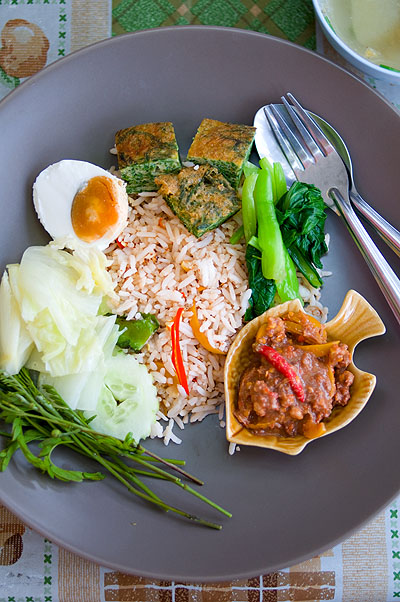
 Lephet thoke is a popular Burmese dish based around pickled tea leaves. The sour, slightly bitter leaves are mixed with shredded cabbage, sliced tomatoes, crunchy deep-fried beans, nuts and peas, a splash of oil and pungent slices of chili and garlic. The dish is versatile: it can be a snack, an appetiser or a palate cleanser. Allegedly it's also a stimulant; a Burmese waiter in Mae Sot, Thailand, told me that I'd be up all night if I ate too much lephet thoke.
Lephet thoke is a popular Burmese dish based around pickled tea leaves. The sour, slightly bitter leaves are mixed with shredded cabbage, sliced tomatoes, crunchy deep-fried beans, nuts and peas, a splash of oil and pungent slices of chili and garlic. The dish is versatile: it can be a snack, an appetiser or a palate cleanser. Allegedly it's also a stimulant; a Burmese waiter in Mae Sot, Thailand, told me that I'd be up all night if I ate too much lephet thoke.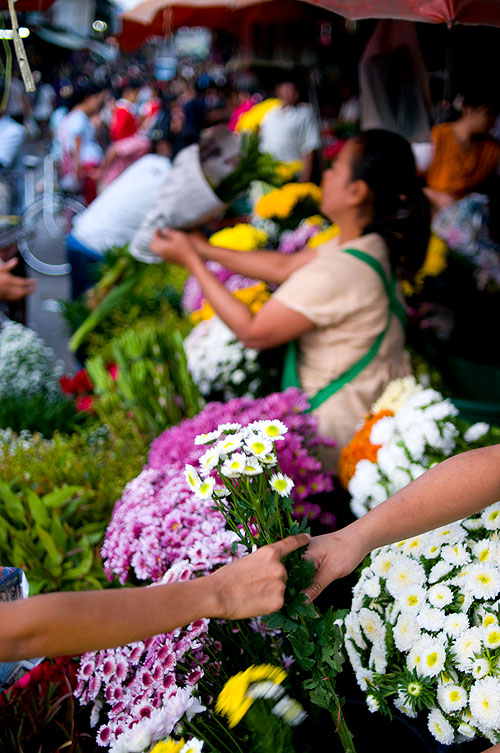 At Mae Sot's morning market, Tak
At Mae Sot's morning market, Tak 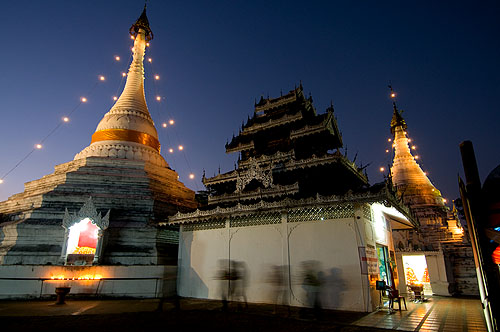
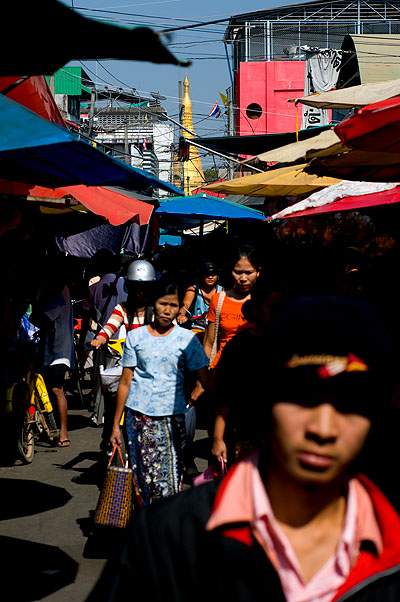

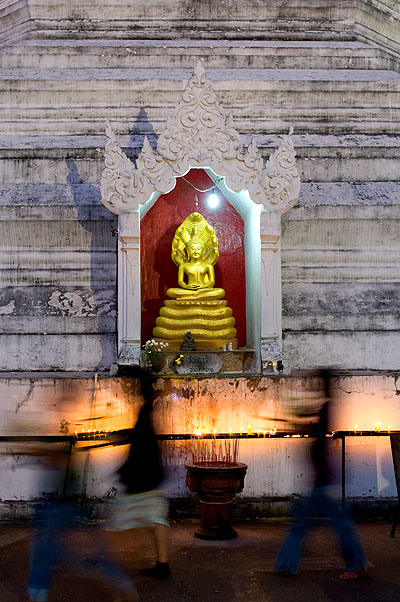
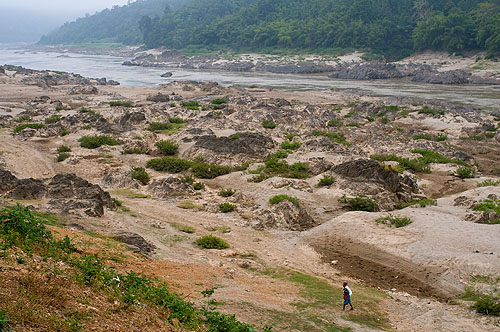
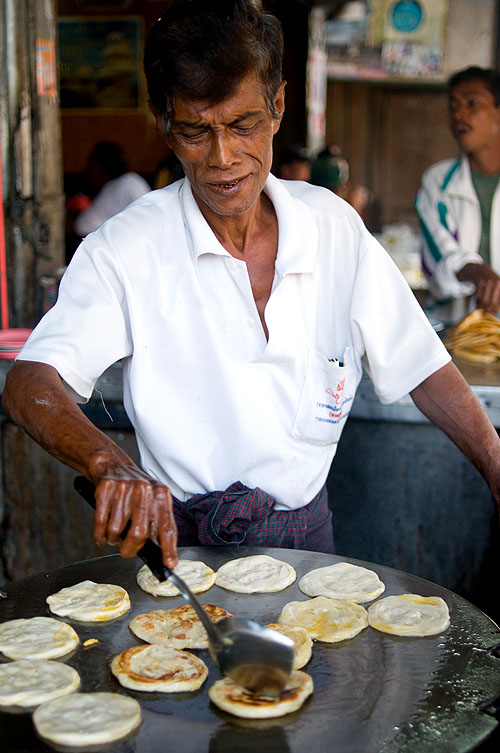 Mae Sot, a bustling city near the Burmese border in Tak province is mostly populated by Burmese refugees. Many of those who live in town are Muslim, and have had a huge influence on the city's food scene. In particular, along the street that runs south of the city's main mosque, you'll find several Burmese/Muslim-owned teashops:
Mae Sot, a bustling city near the Burmese border in Tak province is mostly populated by Burmese refugees. Many of those who live in town are Muslim, and have had a huge influence on the city's food scene. In particular, along the street that runs south of the city's main mosque, you'll find several Burmese/Muslim-owned teashops: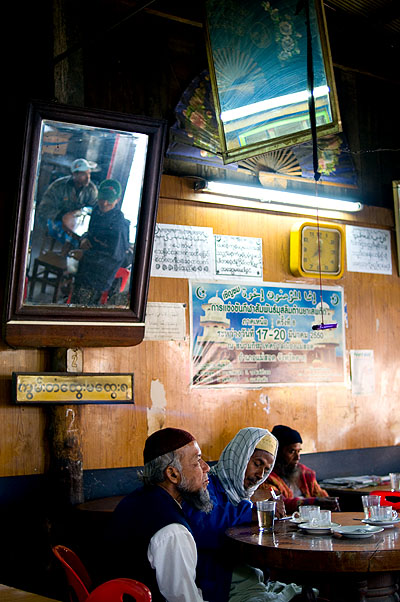
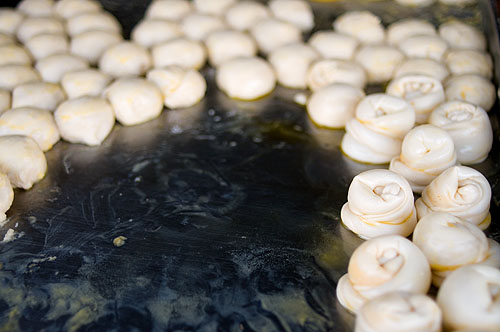
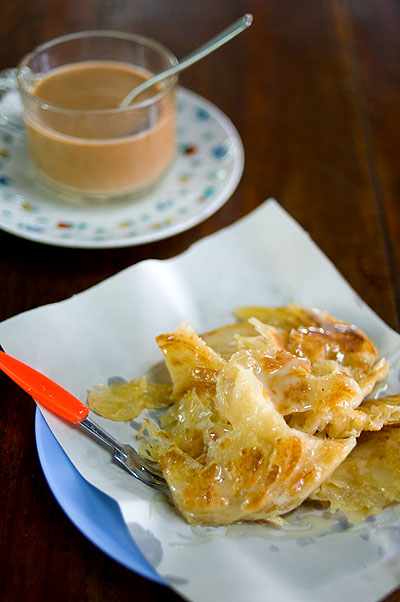
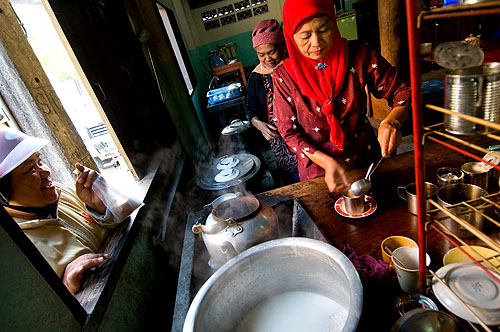
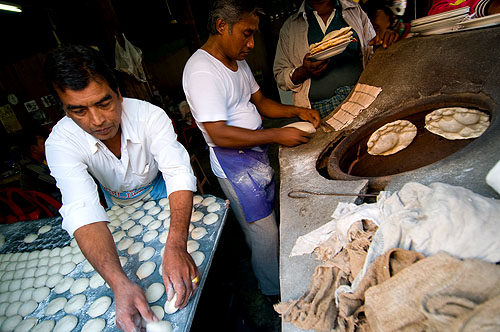
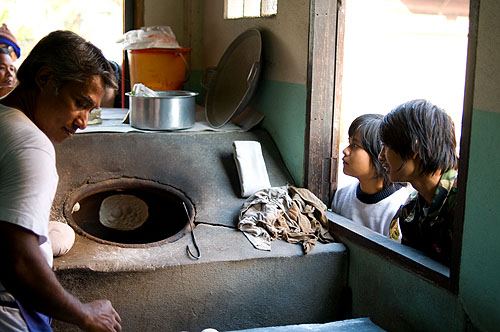
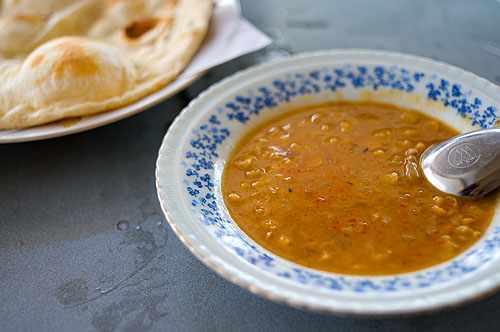
 The name of this dish is, I believe, dialect for, 'rice with meat'. It's a Shan dish that one finds all over northern Thailand, but is best near its traditional homeland.
The name of this dish is, I believe, dialect for, 'rice with meat'. It's a Shan dish that one finds all over northern Thailand, but is best near its traditional homeland.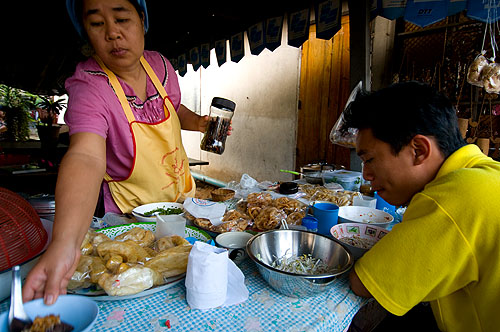
 Mae Sri Bua is a Shan restaurant in Mae Hong Son. The owner/chef, Mae Sri Bua is a native of the city and has been at this a long time. She has trouble walking nowadays, but still manages to make some pretty good eats.
Mae Sri Bua is a Shan restaurant in Mae Hong Son. The owner/chef, Mae Sri Bua is a native of the city and has been at this a long time. She has trouble walking nowadays, but still manages to make some pretty good eats.

 Sesame is an important item in the traditional diet of the Shan people in Mae Hong Son. In addition to the
Sesame is an important item in the traditional diet of the Shan people in Mae Hong Son. In addition to the 





 I'm usually not a huge fan of Thai desserts, but have really been enjoying the sweet stuff up here in Mae Hong Son, northern Thailand. The majority of people in this province are Shan, also known as Thai Yai (or Tai), and have a different set of sweet stuff than the Thais. Essentially, they've made due with the limited set of ingredients they have at hand: rice (regular or sticky, or sometimes wheat flour), sesame and sugar, often from sugarcane (rather than from palm sugar, as is typically the case with southern Southeast Asia).
I'm usually not a huge fan of Thai desserts, but have really been enjoying the sweet stuff up here in Mae Hong Son, northern Thailand. The majority of people in this province are Shan, also known as Thai Yai (or Tai), and have a different set of sweet stuff than the Thais. Essentially, they've made due with the limited set of ingredients they have at hand: rice (regular or sticky, or sometimes wheat flour), sesame and sugar, often from sugarcane (rather than from palm sugar, as is typically the case with southern Southeast Asia).



 As if I haven't been going on about it enough already, I have more exciting khao soi-related news. I was lucky enough to meet up with Andy Ricker of
As if I haven't been going on about it enough already, I have more exciting khao soi-related news. I was lucky enough to meet up with Andy Ricker of  Main street, Pai, during the tourist season, Mae Hong Son, northern Thailand
Main street, Pai, during the tourist season, Mae Hong Son, northern Thailand 






 then stop by my exhibition, The Last Chinatown, which begins tomorrow, December 6th, at
then stop by my exhibition, The Last Chinatown, which begins tomorrow, December 6th, at